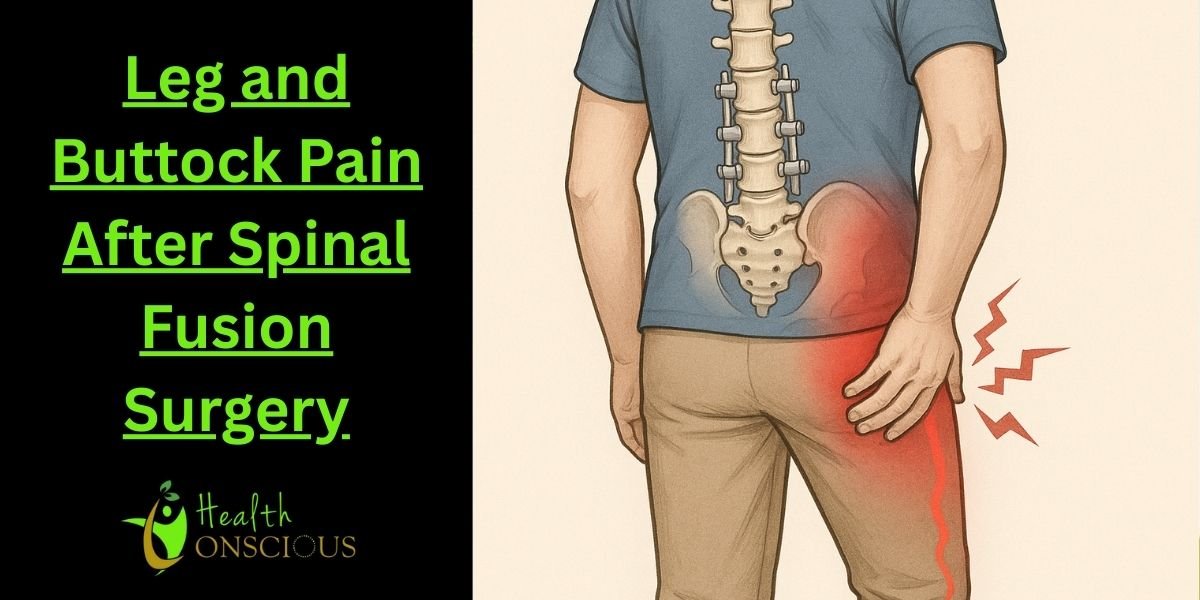Key Takeaways
- Initial leg and buttock pain after spinal fusion is common but usually subsides as the body heals.
- Persistent or new pain may be a sign of nerve irritation, adjacent segment disease (ASD), or hardware issues.
- Physical therapy and home care adjustments are critical for a successful and lasting recovery.
- Recovery duration can differ widely, though most noticeable progress usually happens within the first three to six months.
- Immediate medical attention is necessary for severe, worsening pain, numbness, or loss of bowel/bladder control.
- Building a solid relationship with your doctor plays an important role in handling post-surgery challenges effectively.
Introduction
Waking up from spinal fusion surgery can be a life-changing experience, but it’s often accompanied by a new set of challenges. One of the most common highly reported challenges is leg and buttock pain after spinal fusion surgery. Some level of discomfort is a natural part of recovery, but when the pain becomes severe or doesn’t go away, it can turn into a serious concern.
Clinical studies show that up to 20% of patients who undergo spinal surgery experience a condition known as Post-Laminectomy Syndrome (PLS), which can cause ongoing back, neck, and radiating pain in the legs or arms.
So, understanding the causes of buttock pain after surgery and how to effectively manage it is crucial for a smooth and successful recovery. In this guide we have discussed the common reasons behind leg and buttock pain after spinal fusion or lumbar fusion surgery and provide practical, expert-backed solutions.
Let’s explore how you can find relief from pain and begin a better, healthier life.
What Is Spinal Fusion Surgery?
Firstly, it’s important to understand what Spinal Fusion Surgery involves. The surgery aims to permanently fuse two or more vertebrae together, eliminating movement between them. The main goal is to stabilize the spine, relieve pain caused by conditions such as spinal stenosis, and correct spinal deformities.
During the operation, a bone graft is placed between the vertebrae, and in many cases, screws, rods, or plates are added to keep the bones secure as they heal. Recovery is a gradual process, and while the fused part of the spine becomes rigid, the surrounding areas need to adjust to the new mechanics.
Common Problems After Spinal Fusion Surgery
Post-Surgical Pain
Pain at the surgery site is the most common and earliest problem patients face after spinal fusion. This is a normal part of the healing process and is managed with pain medication prescribed by your doctor.
The intensity of this pain typically decreases over the first few weeks as the incision heals and initial swelling subsides.
Leg and Buttock Pain After Spinal Fusion Surgery
Pain in the leg and buttocks is a frequent complaint. This can be caused by nerve irritation during the surgery itself, muscle spasms, or the presence of swelling and inflammation near the nerve roots.
In many cases, this pain resolves as the body recovers and inflammation decreases. However, if the pain persists or worsens, it may indicate a deeper issue.
Infection or Delayed Healing
Infection is a serious, though rare, complication that can occur after any surgery. Symptoms include increased pain, redness, swelling, and warmth around the incision site, often accompanied by a fever.
Timely treatment with antibiotics is essential to prevent more serious complications. Delayed healing, or a nonunion, occurs when the bones fail to fuse together properly, which can also be a source of persistent pain.
Stiffness and Restricted Movement
After a spinal fusion, the fused vertebrae become one solid bone, which naturally limits flexibility and movement. Patients may experience stiffness and a reduced range of motion, particularly with bending and twisting.
This is a permanent restriction after laminectomy and lumbar fusion, but a physical therapist can teach you how to adapt and strengthen surrounding muscles to compensate.
Adjacent Segment Disease (ASD)
This is a long-term complication where the spinal discs and joints above or below the fused vertebrae experience increased stress and wear. Because the fused segment no longer moves, the adjacent segments take on more load, which can lead to accelerated degeneration and pain.
The Global Spine Journal (2018) reported that about 9% of patients developed symptomatic adjacent segment disease (ASD), on average 4.7 years after spinal fusion surgery.
Hardware Complications
The rods, screws, or plates used for spinal stabilization may occasionally lead to complications. The hardware may shift, loosen, or fracture, leading to new or worsening pain. Sometimes, the implanted hardware can cause irritation to the nearby tissues.
If a hardware-related issue is suspected, your surgeon may recommend a follow-up procedure to adjust or remove the hardware.
How Long These Problems Last After the Surgery?
The back surgery recovery time varies significantly among individuals, but there are some general timelines. The strongest post-surgery pain usually eases within the initial two weeks. Most patients begin to feel significantly better within three to six months, with steady progress in mobility and pain management.
Complete healing, in which the bones successfully fuse, may take a year or even longer. Persistent issues like adjacent segment disease or hardware complications can appear months or years after the initial surgery.
How to Manage These Problems After Spinal Fusion
- Pain Management Through Medication & Therapies Your doctor will prescribe pain medication to help manage immediate post-operative discomfort. Over-the-counter options like NSAIDs may be used later, but only with a doctor’s approval. Non-medicinal therapies like heat/cold packs, massage, and acupuncture can also be effective in managing chronic pain.
- Physical Therapy and Exercise A crucial part of the recovery is physical therapy. Your therapist will guide you through exercises to strengthen core muscles, improve flexibility in unfused areas, and teach proper movement techniques. A study in World Neurosurgery found that combining exercise with cognitive therapy after lumbar fusion improves long-term recovery.
- Home Care and Lifestyle Adjustments During your recovery, simple lifestyle changes can make a big difference. Focus on a balanced diet rich in protein and calcium to support bone healing. Limit activities like heavy lifting, bending, and twisting as advised by your surgeon. You may need to adjust your living space to avoid stairs and ensure easy access to daily necessities.
When to Seek Medical Attention
While pain is normal, certain symptoms require immediate contact with your surgeon or an emergency room.
- Severe, escalating pain that is not relieved by medication.
- Numbness or weakness in the legs, feet, or buttocks.
- Loss of bowel or bladder control.
- Signs of infection such as a high fever, redness, warmth, or discharge from the incision.
Final Thoughts
Experiencing leg and buttock pain after spinal fusion surgery is a common challenge during the recovery period. While it can be frustrating, most issues are temporary and can be effectively managed with the right care.
By working closely with your medical team, and following recommended medication, physical therapy, and lifestyle adjustments, you can get rid of these problems and improve your recovery.
Disclaimer
This article is presented by Health Conscious and is the result of extensive research and specialist review. Its sole purpose is to serve as a guide for patients experiencing leg and buttock pain after spinal fusion surgery, offering insights into the causes and medically-supported treatment options.
Under no circumstances should you attempt any form of treatment, medication, or physical therapy without direct consultation with your doctor.
This warning is especially critical for individuals managing pre-existing conditions such as blood pressure issues or diabetes, or those on a regimen of regular medication.
The information provided here is designed to help you better understand your condition, enabling a more informed and productive conversation with your healthcare provider.
FAQs
Is severe leg pain after spinal fusion normal?
Initial, severe leg pain can be normal due to surgical trauma and nerve irritation. However, if it worsens or appears suddenly after a period of improvement, it should be evaluated by a doctor to rule out complications.
How long after spinal fusion is it safe to bend?
Bending is typically restricted for several months after surgery to protect the fusion. Your surgeon will provide specific guidelines, but most patients are advised to avoid bending at the waist for the first three to six months.
Can buttock pain after lumbar fusion be a sign of a failed fusion?
Yes, buttock pain can be a sign of a nonunion (failed fusion), but it’s more likely to be related to nerve irritation or muscle issues. Your doctor can use imaging tests to determine the cause of the pain.
What are permanent restrictions after laminectomy?
While a laminectomy can relieve pain, it may lead to some permanent restrictions, such as avoiding heavy lifting or repetitive bending, to protect the spine from future injury. A physical therapist can help you learn new ways to move safely.
Trusted Sources & References
- Healthline. (n.d.). What Is Post-Laminectomy Syndrome After Spinal Surgery?. Retrieved from https://www.healthline.com/health/post-laminectomy-syndrome
- Mayo Clinic. (n.d.). Spinal fusion. Retrieved from https://www.mayoclinic.org/tests-procedures/spinal-fusion/about/pac-20384523
- Spine-health. (n.d.). Leg Pain after a Lumbar Decompression Surgery. Retrieved from https://www.spine-health.com/blog/leg-pain-after-lumbar-decompression-surgery
- Cleveland Clinic. (n.d.). Spinal Fusion: What It Is, Purpose, Procedure, Risks & Recovery. Retrieved from https://my.clevelandclinic.org/health/treatments/25168-spinal-fusion
- WebMD. (n.d.). Tips to Help You Recover From Back Surgery. Retrieved from https://www.webmd.com/back-pain/ss/slideshow-back-surgery-recovery


